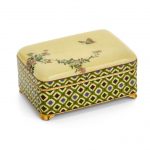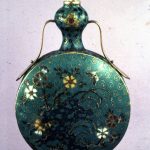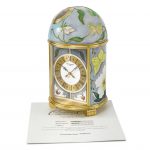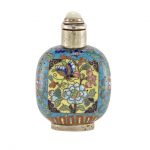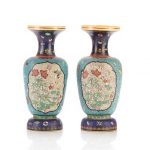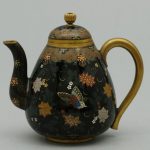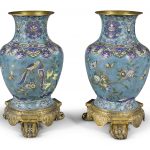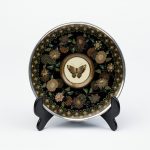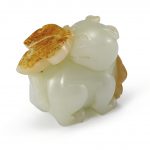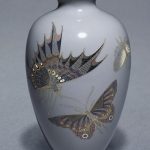Cloisonne butterflies. Cloisonné is an ancient technique for decorating metalwork objects. In recent centuries, vitreous enamel has been used, and inlays of cut gemstones, glass and other materials were also used during older periods. The resulting objects can also be called cloisonné. The decoration is formed by first adding compartments to the metal object by soldering or affixing silver or gold wires or thin strips placed on their edges. These remain visible in the finished piece, separating the different compartments of the enamel or inlays, which are often of several colors. Cloisonné enamel objects are worked on with enamel powder made into a paste, which then needs to be fired in a kiln. Reference: Wikipedia
Namikawa Yasuyuki (1845-1927) A fine cloisonné-enamel box and cover Meiji era (1868-1912), late 19th/early 20th century Of rectangular form with rounded edges and set on four foliate feet, worked in polychrome enamels and silver wire with a scene of a single butterfly floating above a spray of pink chrysanthemums on a light yellow ground, the sides of the box decorated with a lozenge pattern in shades of green, purple and red, gilt-metal mounts, signed on the underside Kyoto Namikawa 3 1/8 x 2 1/4 x 1 1/2in (8 x 5.7 x 3.8cm)
Sold for US$ 18,825 (£ 14,469) inc. premium at Bonhamss in 2019
Flask (moon). Dianthus, peonies and rocks and butterfly. Made of enamel cloisonne metal. Very light with a hammered body. Qing dynasty Ming dynasty Date 1620-1700 (circa)
Reference: © The Trustees of the British Museum
Patek Philippe. A very fine and attractive unique gilt brass solar-powered table clock with cloisonne enamel by L. Rhee and certificate Signed Patek Philippe, Genève, Dome, “Papillons”, ref. 1484M, movement no. 1’804’752, ref. 1484M, manufactured in 2006 MOVEMENT: quartz, cal. 33”’, powered by a photo-electric cell in the dome DIAL: white, Roman numerals on raised gilt chapter ring, gilt and black dauphine hands, framed by a polychrome cloisonné enamel floral decoration CASE: gilt brass, cylindrical, three panels decorated with polychrome cloisonné enamel depicting “Papillons” (Butterflies) signed L. Rhee, photo-electric cell set into the revolving domed top decorated with polychrome cloisonné enamel butterflies and floral leaves, three fluted bun feet, 220 mm. high SIGNED: case and movement numbered, dial signed ACCOMPANIED BY: Patek Philippe Certificate of Origin established by the firm’s distinguished retailer Orologeria Luigi Verga, Milano, and Patek Philippe Extract from the Archives confirming production of the present Dome table clock with cloisonné enamel “Papillons” (butterflies) in 2006 and its subsequent sale on 18 May 2006.
Sold for CHF 175,000 at Christies in 2016
Chinese Cloisonné Enamel Snuff Bottle Qing Dynasty The rounded rectangular form raised on a straight oval foot and surmounted by a tall cylindrical neck, each side with a yellow ground square vignette depicting a cricket and cabbage on one side and butterfly and flowers on the reverse, surrounded by lotus scrolling all reserved on a turquoise ground, above a lappet band at the base. Height 2 1/2 inches.
Sold for $593 (includes buyer’s premium) at Doyle New York in 2018
PAIR OF JAPANESE TOTAI CLOISONNE PORCELAIN VASES
On Satsuma body painted with butterflies to top, body wired with turquoise ground floral and butterfly patterns. Base signed Kinkozan in red. Meiji period, 19th C. H. 24cm (9 1/2 in.)Conditions to top.
Sold for CA$650 at A.H. Wilkens Auctions & Appraisals in 2019
Cloisonne teapot decorated with flowers and butterflies on a black background Made by Namikawa Yasuyuki in Japan, c1890. A cloisonne teapot decorated with flowers and butterflies on a black background. The teapot has a brass handle on one side and a spout on the other. The spout features a floral design on a black background with gold swirls. There is a circular opening at the top of the teapot into which a dome shaped lid fits. Around the opening is is a decorative floral border on an orange-brown background. This border is repeated around the edge of the lid. In the centre of the lid is brass knob.
Reference: Museum of Applied Art and Sciences
A pair of Chinese cloisonné enamel vases on mounts Qing dynasty, 19th century each of baluster shape, the exterior depicting birds perched on blossoming and fruiting branches with flying butterflies, the shoulders with hanging bats between ruyi pendants and stylised lotus scrolls, the neck decorated with lotus sprays amongst multi-coloured meandering foliage, all between further lotus scrolls at the foot and a ruyi-cloud border encircling the rim, all against a bright blue ground, set on gilt-bronze mounts Quantity: 2 70 cm, 27 1/2 in.
Sold for 17,500 GBP at Sothebys in 2019
Cloisonne butterfly dish.
The small copper dish has an applied silver rim and foot-ring. The decoration is of a butterfly in silver and gold yusen enamels on a cream coloured roundel within a border of rings of very small circles. This is surrounded by stylised scrolling chrysanthemums and larch leaves. The outer border of the dish consists of stylised flowers within polychrome enamelled geometric motifs highlighted with areas of chakinseki. The ground is of a mirror-black enamel, and the attention to detail and the quality of the wiring are extremely fine. There is a design by Namikawa for another dish with a central butterfly and surrounding chrysanthemums on pages 187 and 191 of the Kyo Shippo Monyo-shu.
Reference: © Victoria and Albert Museum

